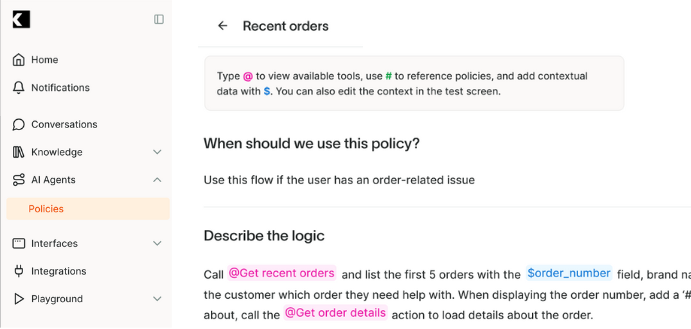Ingredients
Skio, Gorgias, and Kodif.
What are AI Policies?

At Kodif, we’re excited to announce the launch of Policies—a powerful, dynamic solution designed to revolutionize the way CX managers handle customer support. Unlike traditional flows, which are rigid and complex, Policies empower non-technical users to create and manage customer interactions with ease. Written in natural language, Policies make it simple to define and refine customer experiences without needing to rely on complicated flowcharts or scripting. This approach is not only user-friendly but also self-serve, enabling CX teams to quickly translate existing Standard Operating Procedures (SOPs) into automation, saving valuable time and resources.
The flexibility of Kodif Policies ensures that businesses can offer personalized, context-driven support while continuously improving customer experiences. With Policies, you can experiment with different strategies to optimize outcomes such as CSAT, revenue, and retention—all without the need to rebuild complex workflows. Whether it’s automating routine interactions or testing new approaches for high-stakes scenarios, Policies provide a scalable, adaptable solution that aligns with your business goals. While flows still have their place in sensitive, high-risk situations, Policies offer an agile alternative that helps businesses innovate faster and deliver exceptional, tailored experiences at scale.
“Skip next shipment” ticket type explained
The “Skip next shipment” ticket type refers to requests from customers who wish to pause or delay their upcoming subscription shipment. In subscription-based businesses, customers often have the flexibility to manage their delivery schedules according to their preferences. This ticket type is common in industries like subscription boxes, meal kits, and other recurring delivery services, where customers might want to skip a delivery due to reasons like travel, temporary financial constraints, or simply having enough stock of a product.
Handling these requests efficiently is crucial for maintaining customer satisfaction and loyalty. Automating this process through AI policies can significantly reduce the workload on customer support teams, ensuring that customers can easily manage their subscriptions without needing to engage in lengthy interactions or wait for manual processing.
Which Platforms does this AI policy work on?
This AI policy is specifically designed for Skio, Gorgias, and Kodif. However, Kodif integrates seamlessly with all other major platforms, providing a versatile solution for businesses looking to streamline their customer support processes across various systems.
When should I use this policy?
Use this policy when a customer reports that they have not received their shipment despite the order being marked as delivered or expected.
Describe the logic
Type @ to view available tools, use # to reference policies, and add contextual data with $. You can also edit the context in the test screen.
- Ask for the user’s email address
a. Use @get_skio_account_details(email: str) tool to check if the user with that email address exists in Skio.
b. Ask for the order number of the shipment in question.
- Retrieve and Verify Order Details
a. Use @skio_order_details(order_id: str) to fetch the order details.
b. Confirm the shipping status (e.g., “Delivered,” “In Transit,” “Out for Delivery”).
c. If the status is “Delivered,” verify the delivery date and address.
- Check Tracking Information:
a. Use @get_tracking_info to review the shipment’s tracking details.
b. Confirm if the carrier has marked the shipment as delivered.
c. Note any discrepancies (e.g., tracking stopped updating, incorrect delivery address).
- Gather Additional Details from the Customer:
a. Ask the customer to confirm if they’ve checked with household members or neighbors.
b. Ask if the carrier left a notice or placed the shipment in a designated area (e.g., mailbox, porch).
c. Request the customer to confirm that they have not received the shipment despite these checks.
- If Tracking Confirms Delivery:
a. Inform the customer that the shipment is marked as delivered but offer to investigate further.
b. Open a claim with the carrier using @file_carrier_claim(order_id: str).
c. Notify the customer that you will follow up once the claim is resolved.
- If Tracking Shows No Delivery:
a. Inform the customer that the shipment appears lost in transit.
b. Offer a resolution:
Reship the order using
Issue a refund
- If the user selects the reship option:
a. Go to #Reshipment Policy
- If the user selects the refund option go to #Refund Policy
Example policy
Use this policy when a customer reports that they have not received their shipment despite the order being marked as delivered or expected.
Describe the logic
Type @ to view available tools, use # to reference policies, and add contextual data with $. You can also edit the context in the test screen.
- Ask for the user’s email address
a. Use @get_skio_account_details(email: str) tool to check if the user with that email address exists in Skio.
b. Ask for the order number of the shipment in question.
- Retrieve and Verify Order Details
a. Use @skio_order_details(order_id: str) to fetch the order details.
b. Confirm the shipping status (e.g., “Delivered,” “In Transit,” “Out for Delivery”).
c. If the status is “Delivered,” verify the delivery date and address.
- Check Tracking Information:
a. Use @get_tracking_info to review the shipment’s tracking details.
b. Confirm if the carrier has marked the shipment as delivered.
c. Note any discrepancies (e.g., tracking stopped updating, incorrect delivery address).
- Gather Additional Details from the Customer:
a. Ask the customer to confirm if they’ve checked with household members or neighbors.
b. Ask if the carrier left a notice or placed the shipment in a designated area (e.g., mailbox, porch).
c. Request the customer to confirm that they have not received the shipment despite these checks.
- If Tracking Confirms Delivery:
a. Inform the customer that the shipment is marked as delivered but offer to investigate further.
b. Open a claim with the carrier using @file_carrier_claim(order_id: str).
c. Notify the customer that you will follow up once the claim is resolved.
- If Tracking Shows No Delivery:
a. Inform the customer that the shipment appears lost in transit.
b. Offer a resolution:
Reship the order using
Issue a refund
- If the user selects the reship option:
a. Go to #Reshipment Policy
- If the user selects the refund option go to #Refund Policy


